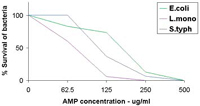| 2005 |

|
YEAR BOOK |
University College Dublin & St Vincent's University Hospital, Dublin 4
|
Improving on nature – modifying natural antibiotics
|
What were we looking for?
When the project started in 2000, less than 1000 chicken gene sequences were publicly available. Since then the complete genome sequence of about 1 billion base-pairs of DNA has been revealed. In addition, nearly 500,000 Expressed Sequence Tags (ESTs – short partial sequences from genes expressed in specific tissues) have given us a profile of where and when most of the 30,000 chicken genes are expressed. We are interested in tracking down the pattern of expression and effectiveness of specific anti-microbial proteins, particularly a family of small cationic, cystein-rich peptides. These are members of a widely distributed group of natural antimicrobials called defensins, found in many animals and even plants
How did we find them?
Proteins involved in the immune response continually evolve to combat new and co-evolving pathogens, resulting in a distinctive enhanced variability compared with other proteins. While some amino acid residues have been preserved throughout evolution, others are highly variable. By searching the genome with particularly sensitive bioinformatics tools we have discovered new defensin peptides. By comparing these sequences and analysing the patterns of variability we can identify those parts of the AMP which are most active in the arms race against bacterial pathogens.

Determining the function of new AMPs
We obtained synthesised versions of the novel AMP sequences and have developed a reliable assay to determine the effectiveness of these AMPs against several pathogens – e.g. Salmonella typhimurium, Escherichia coli & Listeria monocytogenes. Having identified which residues are most significant in the general process of fighting pathogens and applying our knowledge of evolution and protein structure, we are beginning to modify some of the AMPs to try and increase their effectiveness.

Potential uses of AMPs
Even though these AMPs have been found in chickens, the pathogenic organisms they are active against attack a wide range of species. These peptides may therefore have many applications, e.g. animal feed (calves, chickens, pigs), mastitis creams (cows, sheep), bio-health drinks, diabetic ulcer & acne creams (humans). Funded by the Irish Department of Agriculture, NDP 2000-2006, Food Institutional Research Measure (FIRM).
|
|
Contact: Professor Cliona O'Farrelly, Education and Research Centre,
St. Vincent's University Hospital, Dublin 4;
Tel: 01-2774940; Fax: 01-2838123; E-mail: [email protected]